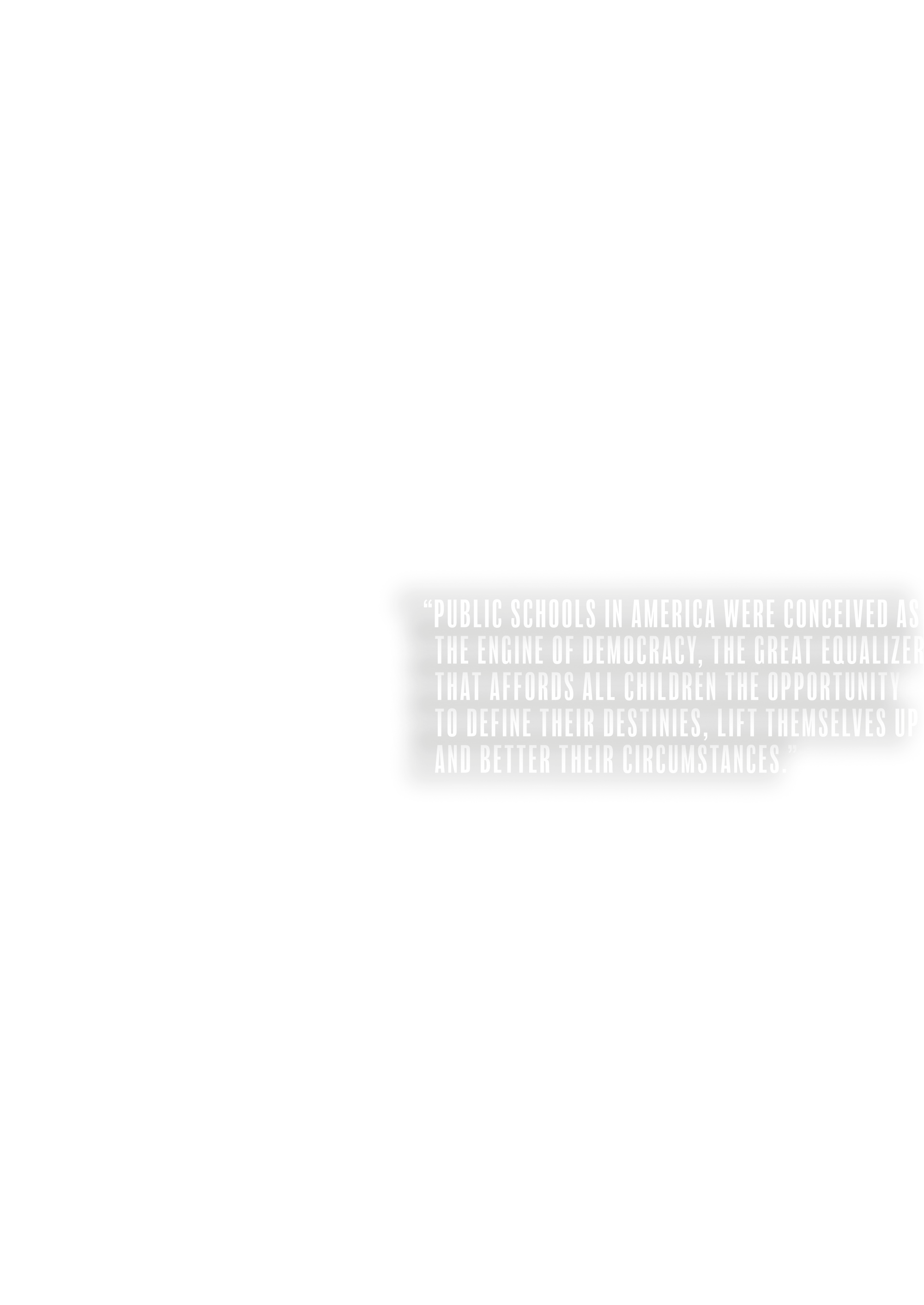


2016 and 2017, two lawsuits in Michigan and California, respectively, asserted that students have a right to literacy. Ella T. v. State of California, filed on behalf of current and former students of three California elementary schools with some of the lowest reading proficiency marks in the state, argued the students had been denied their California constitutional right that all children will be provided with equal access to an education. “Public schools in America were conceived as the engine of democracy, the great equalizer that affords all children the opportunity to define their destinies, lift themselves up and better their circumstances,” the 2017 complaint reads. “An education that does not provide access to literacy cannot be called an education at all.” At the time of the filing, Ella T. was a second-grade student who was reading at a preschool level. The complaint states she was in need of intensive support but was not offered any meaningful interventions.
Gary B. v. Snyder, the first federal case in the nation to assert the right of all students to access to literacy, was filed on behalf of seven students from five Detroit schools who sued the State of Michigan to ensure that Detroit students receive evidence-based literacy instruction. The plaintiffs’ complaint argued that the conditions in their schools were so bad — due to the absence of qualified teachers, crumbling facilities and insufficient materials — that those schools failed to provide access to literacy. “Plaintiffs sit in classrooms where not even the pretense of education takes place, in schools that are functionally incapable of delivering access to literacy.” The plaintiffs argued that because literacy is a fundamental requirement for participation in democracy, the state has an obligation under the U.S. Constitution that it has not upheld.
- Standards-aligned: aligned to state standards for what children need to know and be able to do at each grade level.
- Research-aligned: the way that the curriculum approaches the teaching of reading specifically matches what research has proven is effective, not just broadly speaking (i.e., not just teach phonics, but does it teach phonics the correct way?).
- Cultural responsiveness: are their techniques built into the curriculum that allow the teacher to adjust and incorporate what children are bringing from their homes and communities?
- Usability: some curricula look good on paper but can be too complex to be realistic for teachers to implement.
These cases, coupled with low reading scores on assessments such as the National Assessment of Educational Progress — only about one-third of U.S. fourth-graders scored “proficient” in 2019 — show the moment is again ripe to look at how children best learn to read.
Phonics instruction is the explicit teaching of sound-letter relationships. Whole language instruction posits that children learn to read by being immersed in a rich literary environment, much the way they learn to talk by being surrounded by speaking. But decades of scientific studies have shown that learning to read is not a natural process like learning to speak. Reviews of explicit, systematic phonics instruction — meaning letter-sound relationships are taught following a continuum from easy to more complex skills based on research — in the U.S., the United Kingdom and Australia all found strong scientific consensus around the importance of phonics instruction in the initial stages of learning to read. A 2015 Stanford University study measuring brain waves found that beginning readers who were explicitly taught letter-sound relationships, in contrast with those who learned whole words, increase activity in the area of the brain wired for reading.
In response to the overwhelming evidence that phonics instruction is the best method for learning to read, whole language morphed into the balanced literacy movement. On its surface, the idea of balanced literacy is something to strive for — combining phonics instruction with the idea of immersing children in a varied, print-rich environment to practice their skills and develop a love of reading. However, most experts agree that balanced literacy is just a dressed-up version of the whole language approach with a little phonics sprinkled in.
So why the resistance to phonics? Rebecca Silverman, associate professor at the Stanford Graduate School of Education, said that some teachers feel the instruction takes the life and fun out of learning to read. “Teaching phonics in a skill-and-drill method, when taken to its extreme, can feel very vacuous and can feel like it’s not meaningful,” said Silverman, who specializes in language and literacy development. “So, I think for educators, it feels like focusing too much on phonics takes away from the joy of reading that we want kids to experience. And in fact, they do need to have that joy or they’re not going to engage in it and then they won’t get better.
“I think the other piece of it is that a lot of the recommendations for teaching phonics is focused on kids who are struggling,” Silverman continued. “What has been happening is in those cases is sometimes kids are only provided with phonics instruction or too much phonics instruction and then not provided with other important aspects of learning to read.”
“Our board has made literacy a budget priority and that has really enabled us to invest in deepening teacher knowledge and providing training,” Tong said. “This year, our K-12 program specialists and coaches are deepening our knowledge through participation in the LETRS [Language Essentials for Teachers of Reading and Spelling] training as part of the pilot group that we were invited to join with our Sacramento County Office of Education. It’s really been a great experience for us.”
Elk Grove USD Board President Beth Albiani said the importance of teaching reading goes well beyond English language arts. “We are looking at our literacy practices year round with our content area steering committees, as well as within school-based professional learning communities when schools are in session,” she said. “We recognize it’s important, especially in our primary classes, that the whole class is literacy-focused, not just in reading time, but in all subjects such as math and science.”
Both Tong and Albiani point to the important role that the Sacramento County Office of Education has played in the initiative. “We’ve taken advantage of opportunities that the Sacramento COE has brought to our area, including a lot of research-based knowledge on reading. Reading researchers have given presentations that all of our reading coaches have gotten to experience together,” Tong said. “Also, for the past two years, Sacramento County Office of Education has partnered with us to provide early literacy training to our elementary site administrators as well as coaches — we really benefit from their knowledge and expertise. We know that building capacity is not easy and it will take time.”
Elk Grove is doing it right in rolling out a new curriculum and program thoughtfully and prioritizing teacher learning, according to Nell Duke, professor at the University of Michigan Graduate School of Education who specializes in early literacy development. “We know from research that just adopting a new curriculum will not get us where we need to be on something like SBAC scores or NAEP scores,” Duke said. “What doesn’t work is a day at the beginning of the year saying, ‘Here’s our new curriculum,’ and then that’s that. It needs job-embedded, ongoing professional learning to really make that curriculum come to life and work well. In California, I know you have a lot of coaches. Coaching is a really powerful tool for supporting teachers in improving their practice —we have a lot of research on that. So coaching teachers around implementation of a new curriculum would be a good example of something that I’d want to see put in place.”
Silverman from Stanford agrees that teacher preparation is key. “A great curriculum is not going to go anywhere without a teacher who knows how to use it and knows how to differentiate it,” she said. “I think that districts have gone to the solution of a curriculum to try to solve a problem, but that’s not necessarily the best solution to the problem. It would be more through teacher preparation, coaching and professional development.”
“I think that there are so many people who erroneously think that all we need is for kids to be able to read the words, and then they’ll be able to perform well on things like the NAEP and California’s Smarter Balanced Assessment,” Duke said. “We know from research that’s not the case — that ‘word reading’ alone and phonics instruction alone will not get students where we need them to be to perform well on those assessments. What we always say is that high-quality phonics instruction is necessary but not sufficient to get kids where we need them to be.”
- Phonemic awareness — the understanding that spoken language words can be broken into individual phonemes — the smallest unit of spoken language.
- Phonics — the relationship between the letters (or letter combinations) in written language and the individual sounds in spoken language.
- Fluency — the ability to read as well as we speak and to make sense of the text without having to stop and decode each word.
- Vocabulary — vocabulary development is closely connected to comprehension. The larger the reader’s vocabulary (either oral or print), the easier it is to make sense of the text.
- Comprehension — the complex cognitive process readers use to understand what they have read.
The reading wars take the focus away from the many things that children need to become successful readers, according to Silverman. “If there’s an overemphasis on just attending to meaning, which is, I think, where the worry is, then kids don’t realize that you actually can unlock words by knowing what the sounds are and how to use letters set to make those sounds,” she said. “So, an overemphasis on meaning can detract from kids being able to learn, to decode. And that learning to decode is really important for them to be able to access texts that are beyond what they already know.”
Duke agreed, referencing the fact that U.S. students have not seen significant variations in NAEP reading results for the last three decades. “Just changing one or a few aspects of literacy instruction isn’t going to be enough to move the needle on these complex assessments,” she said. “This is about improving many different aspects of what happens when teachers are teaching children to read and to write, as well as what’s happening in science and in social studies, because building that world knowledge actually really influences reading and writing achievement.”
Both experts in the field and laymen would agree that only being able to decode the words on a page, without comprehending the meaning behind them, is not the goal of reading. But explicit and systematic phonics instruction give students the foundational skills to be able to develop their reading skills and become a more productive member of society. As summarized in the court’s ruling in the Gary B. case in Detroit, “In short, without the literacy provided by a basic minimum education, it is impossible to participate in our democracy.”
Kimberly Sellery is managing editor for California Schools.